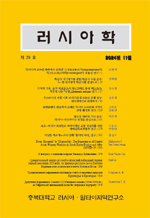К вопросу о сущности реформы орфографии 1918 года в России
On the issue of the essence of the spelling reform of 1918 in Russia
- 충북대학교 러시아 알타이지역 연구소
- 러시아학
- 제30호
-
2025.05263 - 288 (26 pages)
-
DOI : 10.24958/rh.2025.30.263
- 3

The subject of the study, the results of which are presented in this article, are such features and patterns of the language reform of 1918 that allow us to reveal its essence and features. The relevance of this study is due to the fact that at present in the linguistic literature there is no unambiguous point of view on the nature, essence and features of the language reform of 1918. Despite numerous studies of the spelling reform of 1918, a number of issues remain unclear that can serve as the subject of a special study. Firstly, what was it. What were the real goals of the spelling reform of 1918? Secondly, did the spelling reform of 1918 really pursue the goals that were declared in the decree announcing this reform. Thirdly, it is necessary to evaluate the linguistic and cultural consequences of the spelling reform of 1918. The main goal of the study was to determine the essence of the spelling reform of 1918 in Russia, as well as its consequences. The author included the following tasks among the main tasks of the study: 1) what was the actual semantic function of the abolished letters Ѣ, Ї, ϴ and whether they actually had any semantic function; 2) what was the actual meaning of indicating a hard sign at the end of a sentence; 3) is the replacement of З with С in prefixes ending in З before voiceless consonants, including iz, voz, raz; roz, really equivalent; bottom, without, through, across5) or do they give the word a different meaning 4) are the equivalents in the genitive case of adjectives and participles and pronouns of the endings ОГО, ИЕ, and the endings АГО, ЯГО valid 5) are the equivalents of the pronouns “ОНТ and ОНѢ in the nominative case of the feminine plural”; are the equivalents of the pronouns “ОДНИ, ОДНИМИ and ОДНѢ, ОДНѢХ, ОДНѢМИ in the feminine gender” valid 7) are the feminine pronouns ЕЁ and ЕЯ really equivalent in the genitive case of the singular”. During the study, carried out with the help of the following methods were used: construction analysis of linguistic patterns, analysis of the meanings of words and sentences, as well as logical methods: analysis, synthesis, induction, deduction, abstraction, generalization the following was established. Due to the abolition of the letters Ѣ, Ї, ϴ, the words есть (to be) and есть (to eat), если (trees) and если (to eat) became homonyms, that is, the feminine plural noun эл, became a homonym of the imperfective verb of the forgiving tense; due to the abolition of the letter Ѣ, the words беска and беда (unclean spirit) began to have a definite common spelling; due to the abolition of the letter Ї, the words Миръ (absence of war) and Мїръ (universe, environment) ceased to be distinguished; due to the disappearance of the letter ϴ, names and titles of Greek origin dissolved in the mass of other names with the sound [f], due to the introduction of the combination of letters з/с in the prefix Без, with the simultaneous abolition of the letter Ѣ, some words began to have an ambiguous meaning, including a blasphemous meaning. Due to the abolition of the endings ago yago and their replacement with ого, its written gender identifiers of adjectives and participles were lost; the abolition of the hard sign at the end of words led to the introduction of a presumption of hardness of word-ending consonants. The abolition of the differences between the pronouns ОНИ and ОНѢ, as well as ОДНИ and ОДНѢ led to the fact that the 3rd person plural pronouns ОН, ОНА, ОДИН, ОДНА disappeared gender distinctions, as if gender depended on person and number. Finally, the abolition of ея led to the fact that the pronoun ЕЁ ceased to be declined by case.
Предметом исследования результаты которого изложены в настоящей статье выступают такие особенности и закономерности языковой реформы 1918 года которые позволяют раскрыть ее сущность и особенности. Актуальность данного исследования обусловлена тем, что в настоящее время в лингвистической литературе нет однозначной точки зрения на природу, сущность и особенности языковой реформы 1918 года. Несмотря на многочисленные исследования орфографической реформы 1918 года, остается неясным ряд вопросов, которые могут послужить предметом специального исследования. Во - первых, что это было. Каковы в действительности были подлинные цели орфографической\ реформы 1918 года. Во - вторых, действительно ли орфографическая реформа 1918 года преследовала те цели, которые были заявлены в декрете об объявлении данной реформы. В-третьих, необходимо оценить те лингвистические и культурологические последствия, которые принесла за собой орфографическая\ реформа 1918 года. Главной целью исследования являлось определение сущности реформы орфографии 1918 года в России, а также ее последствий. К числу основных задач исследования автор отнес следующие задачи: 1) какую в действительности смысловую функцию несли отмененные буквы Ѣ, Ї, ϴ и несли ли в действительности они какую - либо смысловую функцию 2) какой в действительности смысл несло указание твердого знака в конце предложения; 3) действительно ли эквивалента замена З на С в приставках заканчивающимися на З, перед глухими согласными в том числе из, воз, раз; роз; низ, без, чрез, через5) или они придают слову другой смысл 4) действительна ли эквиваленты в родительном падеже прилагательных и причастий и местоимений окончания ОГО, ЕГО, и окончания АГО, ЯГО 5) действительно ли эквиваленты местоимения «ОНИ и ОНѢ в именительном падеже множественного числа женского рода»; действительно ли эквиваленты местоимения «в женском роде ОДНИ, ОДНИМИ и ОДНѢ, ОДНѢХ, ОДНѢМИ» 7) действительно ли эквивалентны в родительном падеже единственного числа местоимения женского рода ЕЁ и ЕЯ». В ходе исследования, осуществлявшегося при помощи использовались такие методы как: строительный анализ языковых закономерностей, анализ смыслов слов и предложений, а
I. Введение
II. Основная часть
III. Заключение
Литература
(0)
(0)